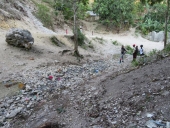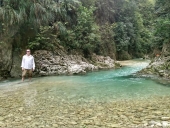


hans muster wrote:If you are afraid of pigs destroying stone walls you build to slow down the water, have you thought of wire basket gabions? If built close enough from each other, they slow down the water and buffer water discharge.
As said above, this will not replace a vegetated uphill area, but may help.

John C Daley wrote:Tom, did you consider any of my points?

John C Daley wrote:Looking at this job with my dam building and stream management experience in Australia mainly, I dont see much hope for this project as its presented.
As others have asked;
- will it silt up
- will it be swept away
- how often does the water course flood
- what depth of flood occurrs?
I have many questions before I can make any suggestions .
- Have you contacted Engineers Without Borders?
- Have you had any input from people who have seen such walls destroyed?
- what volume of water per day / week are you seeking to capture?
- have you considered a curved wall to create a stronger wall?
- Could you have a small intake box and have a tank built away from the water flow if it flooded and send that water to the kiosk?
- The 4 ft trench is a good idea, but it may need to be keyed in with sloped sides to grip the foundation.
- What is the projected cost of the project?
- Can the community afford to have it swept away in a flood?
- As Jay suggested have you planned anyway to slow the water down and even store some in vegetation?

Michael Cox wrote:I've had a look at the video now. I have a MUCH better understanding of what you are working with, and what you are trying to achieve. There is some existing water treatment and distribution infrastructure that you want to tap into in the nearby town. Intention is to build a pipe from the weir down to the kiosk, and distribute from the kiosk itself.
It's not so much about water storage behind your dam, as it is about concentrating the limited flow in one spot, and then channeling it via pipe to the kiosk?
The karstic limestone is challenging. It looks like the water is sinking into subterranean channels, but there is still some kind of subsurface flow - hence the spring in the otherwise dry river bed.
I think your hypothesis that declining flows over time may be due to uphill deforestation are plausible. Deforestation makes storm related flows much more intense, and reduces the amount of water the soil can hold. You explain in the video that charcoal burning is a local major industry, so you would be fighting an uphill battle to reverse that trend. But there are other techniques that you could employ in that area to slow subterranean flows. I mentioned vetiver above. Vetiver hedges would have all sorts of benefits, beyond helping the local water cycle generally. It provides mulch for farmers crops, reduces irrigation needs for farmers, increases plantable areas by stabilising slopes, reduces erosion of soil etc...
I appreciate that this is slightly outside the scope of your project, but you may find a partner organisation in your area that maybe interested in helping your local land users understand and employ it. There is also a potential business for fairly small scale growers to farm vetiver slips for using in other projects.
The watershed in question is comparatively small - just over 1km horizontally from your project upstream to the ridge line. This seems like quite a manageable area to look at upstream works - smaller check dams etc...

Michael Cox wrote:
Joseph Lofthouse wrote:
The large cobbles in the creekbed, and lack of vegetation or lichens, show that the stream moves a tremendous amount of sediment downstream during runoff events. A delta of cobbles and boulders exists in river below.
Agreed. Although from google maps it looks like there isn't an obvious tract of exposed soil in the water catchment to erode rapidly.



Joseph Lofthouse wrote:An intake system located completely underground does not require maintenance.


Joseph Lofthouse wrote:We understand how to pour concrete underwater. Lots of online resources and tutorials exist. You might also place an over-sized diversion pipe under the structure, to drain water away while under construction. Then plug it later.
Yes, as of now the plan is to first build a sand bag weir behind the dam with a 4in drain pipe that will run through the dam wall. If we need to remove more water, I reckon we will set up 1-2" pvc siphon pipes over the wall site as needed. then when the pour is complete, turn off the ball valve on outside of dam wall.
Do you intend to collect the water uphill of the dam, through the underground gravel deposits?
No. Simply create a tall enough pool to act as a "settling tank" and to elevate the intake box/pipe above the ground. This little nook is the highest point in the valley where this disappearing stream still emerges. This region of south west Haiti (Department Grand Anse) is know for hyrdological anomalies, e.g. a fresh water spring is next to a salt water spring, a 98F degree hot sulfur spring is 100 yards from a dozen 66F degree cold springs. The temp of the water coming out at our site was a consistent 76.4F degrees--which leads me to believe it is coming from surface water higher up in elevation and reemerging from this site.
Flash floods can easily overwhelm structures. I wonder if the whole structure needs an apron? Everything uphill of the dam will fill with gravel during the first major run-off event.